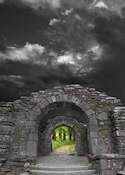(If you are looking for details about current version of Tableau: Gate Watch, it is here.)
Gate Watch (2019)
Collaborative Cinematic Storytelling

You and your companions are members of the Gate Watch—charged to keep an eye on the border between realms. Who built the gate? What is on the other side? Why are you watching? What are you guarding against? These are the questions you will answer as you explore the mystery of the Gate. Every game session is different, every world, every Gate unique.
Gate Watch is a creative tabletop storytelling game for 2-5 players, where player interactions take the mystery of the Gate to dramatic resolution. It is diceless and GMless and uses 18 poker-sized cards, with rules on front and inspirational images on the back. You will also need two sheets of paper, some index cards, and some markers. The typical playtime is about 2-3 hours.

Overview of Play
Players first choose the Gate for this game, optionally selecting or drawing one from the 18 images on the back of the cards. Reading through the cards, they together create a Map and describe Locations, establish Truths & Mysteries, and ask key Questions of fellow Watchers. Plot Hook cards help players set key goals for Acts 1 and 2, then take turns setting Scenes that drive the story forward. Resolution cards increase tension or resolve complications until a clue reveals one of the Gate’s Mysteries in Act 3.
Gate Watch inspires players to be creative, supporting a nearly infinite variety of potential stories. Thus far in play-testing, the Gate collaboratively selected by players resides in a wide variety of settings & genres:
- in a classics fantasy, with the gate lying between the real-world and the Greek heaven & hell, and Watchers possibly hired by Charon;
- in a 1950’s noir mystery, featuring the gate between a Hollywood producer’s mansion and the hardscrabble blue-collar world of post-war Los Angeles;
- in a sci-fi adventure, where a collapsing underground mutant civilization has a hidden exit to a post-apocalyptic landscape;
- and in a dark fantasy, where a water well located in a German farming village at the end of WWII leads into the perilous lands of the fae, but may be the only escape from invading Russians.
We’ve found the mechanics of Gate Watch work well for experienced gamers as well as those who are completely new to collaborative story games. From improv actors to experienced role players, a wide range of people have found the instructions and mechanisms easy to understand and fun to play. The resulting stories were imaginative, the settings and genres intriguing, the play dynamic, and most importantly, all had a satisfying ending in just a couple of hours of play. A fun evening entertainment.
First Edition AVAILABLE NOW!
KICKSTARTER ORDERS COMPLETE: SALES ARE OPEN TO ALL!
All Kickstarter orders were shipped, including the limited “Storyteller’s Edition”, so I am now able to accept new orders for Gate Watch from from the public.
There are currently three editions available:
- Gate Watch: “Just the Cards!” Edition, with 18 poker-sized Print-On-Demands cards and no box is available for $9.95 from DriveThuRPG.
- Gate Watch: “Print & Play” Edition is designed for printing on 3 sheets of Avery 5392 “Meeting Badge” Cards is now available for $4.00 from DriveThruRPG.
- Gate Watch: Retailer Edition, same as “Just the Cards” Edition but shrink-wrapped with a 19th card on the back with a brief description of the game and ISBN bar code. Contact ChristopherA@DyversHands.com if you would like to place an order.
We are considering slightly more expensive ($15) Print-On-Demand edition with a tuck box from TheGameCrafter — let us know if there is interest.
Everyone in the Kickstarter who order the “Just the Cards!” edition can now review the game on DriveThuRPG. — we’d appreciate your kind words!
Please also consider subscribing to our low-volume email list. We are now play-testing our next Kickstarter “Just the Cards!” design — a stand-alone companion to Gate Watch called Twilight Road: “You are Travelers along the Twilight Road. Who travels along it? Where does the Twilight Road *begin? Where does it end? What crosses it? What makes the Twilight Road different from other roads? If you leave the road, can you return?”
Reviewer Quotes
“You wouldn’t think a whole three-act story game could fit in 18 playing cards, but Gate Watch cleverly mixes a combination of well-honed story prompts, act-specific scene frames, and a story hook brimming with potential, focusing on just what’s needed to improvise compelling fiction.” — Aaron A. Reed, author of the Archives of the Sky story game.
“Gatewatch is an intriguing, distilled world-crafting, story-telling, and role-playing experience in the guise of a simple game. I wouldn’t be surprised if some of the principles it is based on are used in basic literary, plot-writing or directing courses. Involve everybody around the table and collaboratively set the background through a pool of questions. Create exciting scenes involving both the background and the participating characters with nothing but narration. Dice? Nah, too random. Cards? Yes, but only a handful. Rules? Less than a single page. Duration? As long as you wish. Fun? Loads! The game can explore any setting and genre you want it to, with everybody simultaneously starring and directing. Veteran gamer? Hardcore role-player? Total newbie? It doesn’t matter. All you need is a vivid imagination.” — Antonios S, RPG.net Reviewer & Columnist
Inspirational Quotes
“The world is all gates, all opportunities, strings of tension waiting to be struck.” —Ralph Waldo Emerson
“Yog-Sothoth knows the gate. Yog-Sothoth is the gate. Yog-Sothoth is the key and guardian of the gate. Past, present, future, all are one in Yog-Sothoth.” —H. P. Lovecraft
“My paintings always feature trails that dissolve into mysterious areas, patches of light that lead the eye around corners, pathways, open gates, etc.” —Thomas Kinkade
“The enemy is within the gates; it is with our own luxury, our own folly, our own criminality that we have to contend.” — Marcus Tullius Cicero
“Still round the corner there may wait, A new road or a secret gate.” —J. R. R. Tolkien
“It is easy to go down into Hell; night and day, the gates of dark Death stand wide; but to climb back again, to retrace one’s steps to the upper air - there’s the rub, the task.” —Virgil
“Near the gates and within two cities there will be scourges the like of which was never seen: famine within plague, people put out by steel, crying to the great immortal God for relief.” — Nostradomus
“We did not choose to be the guardians of the gate, but there is no one else.” —Lyndon B. Johnson
About the Quickstarter
Our crowd funding drive on Kickstarter started on May 25th and was fully funded within a day, and ended on June 14th. All the regular orders were shipped on time in August, and the limited “Storyteller’s Edition” was shipped in early October.
Though I have been involved with a number of successful Kickstarter projects, this was the first that I ran under my own own name. I love the creative power of constraints, so I released this game as a Quickstarter, a Kickstarter initiative that embraces the following ethos:
- Quickstarter is about thinking small and simple.
- Quickstarter is keeping it fun & “Do It Yourself”.
- Quickstarter doesn’t take over your life and is not a job.
To this end, I followed these rules:
- Plan it in three months or less.
- Campaign for less than 20 days.
- Funding goal under $1,000.
- Rewards under $50.
- A short & sweet video or none at all.
- No PR or media outreach (unless contacted).
- No paid ads on social media.
- No stretch goals.
- Ship quickly.
- Include “Quickstarter” in the campaign name.
I will report out my observations and lessons learned from this Quickstarter later in an update on this page.
Keeping the Price Low, the Shipping Simple
Also in the spirit of simplicity, this game consists of just the 18 poker-sized cards. There is no box: instead our printer, DriveThruRPG, wraps the 18 cards in a transparent band. This allows us to offer the printed cards for our US customers for less than $10. Less than the cost of a movie! We do plan to offer a version from TheGameCrafter with a tuck box at a slightly higher price.
The advantage of this Print-on-Demand approach is that it allows production of this game to be lean, quick, and simple, so that we can easily offer more story games like this in the future. It also has the added benefit that I don’t have to inflate the prices to cover any potential production or postage hikes, so I can offer the best possible price!
About the Author
I am fascinated by the art and craft of collaboration, and have its practice and the study of how and why collaboration works at the center of my professional career as an entrepreneur, a software architect, as well as a creator, producer & publisher in the game industry.
In the paper RPG games industry I have been the the owner/publisher of the popular RPG community website RPGnet since 2001. As a creative collaborator I most notably produced Chaosium’s Beyond the Mountains of Madness role-playing game, which won the Origin’s Award for “Best Roleplaying Adventure” in 1999.
In the board games industry I resurrected the original 1987 edition of Arkham Horror and licensed it in 2005 to Fantasy Flight for its best-selling 2nd edition of this board game series.
In the computer games industry, I’m the founder of Skotos Tech, an online game company where I was lead for the social Castle Marrach and Lovecraft Country online games and producer for mobile adaptions of several strategy games by Reiner Knizia and Michael Schacht.
Recently, I have been doing more personal projects, directly creating releases for the tabletop industry: I am co-author with Shannon Appelcline of “Meeples Together: How and Why Cooperative Board Games Work”, a book on the practice, design and theory of cooperative games, best exemplified by games like Pandemic, Hanabi, Arkham Horror, and Gloomhaven. We had a successful Kickstarter in late 2018 and the book will be available to the public in March of 2019. We are working on a sequel on the topic of collaborative play for publication in 2020.
With my long-time co-author Shannon Appelcline, I am also the creator & co-author of an upcoming graphic novel Touched, as well as producer of two previous comics associated with our online games: Lovecraft Country: Return to Arkham & Castle Marrach: Awakenings.
I have been writing about collaboration for several decades. My Life with Alacrity blog talks about the principles of cooperation, collaboration, and governance while my Rebooting the Web of Trust workshops imagine the future of collaboration on the internet.
I have been a fan and supporter of games (especially roleplaying games) for decades, with old favorites including Call of Cthulhu and RuneQuest II. My new favorites are the collaborative games that have emerged in the last couple of decades, both in the form of GMless story games as well as in board games.
I am avid supporter of other games designers on Kickstarter and Patreon.
Ludology
This story game was first inspired when I was researching various lists of thematic storytelling archetypes: 7 Basic Plots (Booker), 20 Master Plots (Tobias), 36 Dramatic Situations (Polti), 37 Photoplay Plots (Hill), Basic Patterns of Plots (Foster-Harris), Poetics (Aristotle), Shape of Stories (Vonnegut), and the TV Tropes Wiki (dyvers hands).
Though not explictly named by these lists, many of the plot archetypes have binary sides. Good Guy/Bad Guy, Quest/Return, etc. Having recently played the gmless games Archipelago II (2009) & The Quiet Year (2013) which both made extensive use of a collaboratively created map, I realized that a map with two sides might be a quite powerful plot device. That lead thematically to focusing on a place between the maps — the Gate — as being an interesting point of play to explore.
This game’s next biggest inspiration was when I was looking at pricing at Print-on-Demand cards for another game, and discovered that there were significant price breaks at 18 cards. So I set for myself a goal to create a game only using 18 cards, and keep the price below that of going out to a movie. Given these constraints, one of the first things I realized was having all the backs of the cards be the same was a waste. After several playtests using different inspirational images for the gates on the card backs, this contrained approach has to be quite powerful. If successful, I hope to offer some more 18 card story games.
I have been using for some other of my story games a resolution mechanism inspired by Archipelago II (2009) (which in turn was derived by Itras By (2008)), which extends the traditional improv “Yes, and…” with some additional choices. Having just six such choices, balanced between good and bad, fit well into the constraints of having just 18 cards.
Finally, using the constraint of player questions to define other player’s characters rather than player’s creating their own characters was inspired by A Penny for My Thoughts (2009), and of course general improv “Yes, and…” practices.
I play a lot of story games, so I’m sure there many other sources of inspiration that influenced this game, but these are the most important ones.
More about the ludology behind this game in Kickstarter Update #4: The Four Kinds of Cards.
Credits, Production Notes & Colophon
Published by: Dyvers Hand Productions.
Written & Produced by: Christopher Allen. ©2019 by Christopher Allen.
Card Headlines Font: Frutiger
Card Body Font: Méridien
Tools: The cards were composited for POD (Print-on-Demand) publishing using Keynote for Macintosh, and the Print-to-Play version was layed-out using Pages for Macintosh. Let me know if you’d like a copy of my raw templates — they both are surpisingly easy to use to create POD games.
Images: All the images used in the game have been either permissively licenced (Creative Commons or other open content license), or permission has been explicitly granted to me by the image creator.

- Photo by Jacob W. Frank at JWFrank.com, from Wikimedia Commons, licensed CC0.

- Composited by Christopher Allen, from:
- Photo by Prester Johnstock on DeviantArt, used with permission.
- Photo by Paul L Dineen on Flickr, licensed CC-BY.
- Photo by Chris Hoare on Flickr, licensed CC-BY.

- Photo by MaxPixel, licensed CC0.

- Photo by Hugh Cotter on Wikimedia Commons, licensed CC-BY-SA.

- Photo by SabreGuy29 on Flickr, licensed CC-BY.

- Photo by Jorge Láscar on Flickr, licensed CC-BY.

- Photo by Angel Schatz on Flickr, licensed CC-BY.

- Photo by Pixabay, licensed CC0.

- Photo by Metropolitan Museum of Art, donated to Wikipedia Commons, licensed CC0.

- Photo by Thomas Quine on Flickr, licensed CC-BY.

- Photo by Jorge Tutor from jorgetutor.com from kirikou.com. Used with explicit permission.

- Photo by Nikola Knezevic on Unsplash, licensed Unsplash.

- Photo by Kouji Tsuru on Unsplash, licensed Unsplash.

- By Chris Chadd on Pexels, under Pexels license.

- Photo from U.S. Army on Wikimedia Commons, licensed CC0/Public Domain.

- Original photo by Rafidio on DeviantArt, use granted with explicit permission. Final derivate by Pixabay, licensed CC0.

- Photo by Miroslav Vajdic on Flickr, licensed CC-BY-SA.

- Photo from Moby Games, fair use.